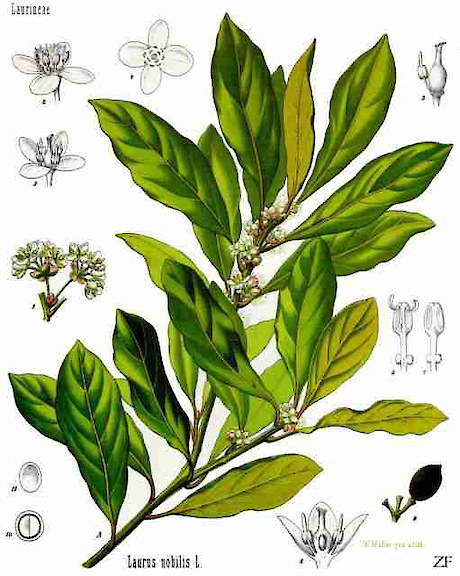Laurus nobilis
Download info sheetFamily Name
Lauraceae
Common Name
Bay/Sweet Bay/Laurel
Description
An evergreen shrub, a bay tree can reach over 7 metres and 2 metres wide if not clipped. The distinctive leaves are dark green, leathery and ovate, making this an ornamental as well as useful plant. The bark of this tree is smooth and has a reddish-green colour. The stems are woody and make an ideal base for herbal and floral arrangements. Flowers bloom in late spring and are small and yellow, appearing at the base of the leaf stem. These flowers then turn into hard, green berries which will eventually become purple/black. Sweetly aromatic, the leaves have a strong, distinctive taste and retain their flavour well during cooking.
Parts Used
Leaves & Berries. Branches are used as a strewing herb or hung to freshen air. The leaf is used in bouquet garni, marinades & stuffing. The leaf can be boiled in milk to flavour custard & rice pudding, used as a garnish, placed in rice & flour bins as a weevil deterrent and crumbled into pot pourri.
Constituents
In the fruit there are essential oils and fatty oils present. The fruit is pressed and water extracted to obtain these products. The fruit contains up to 30% fatty oils and about 1% essential oils (terpenes, sesquiterpenes, alcohols and ketones). The leaves contain about 1.3% essential oils (Ol. Lauri folii), consisting of 45% eucalyptol, 12% terpenes, 3-4% sesquiterpenes, 3% methyleugenol and other α- und β-pinenes, phellandrene, linalool, geraniol and terpineol.
Medicinal
The leaf is infused to relieve indigestion, colic & flatulence and to stimulate the appetite. The essential oil is used to calm the autonomic nervous system and when added to a bath, it stimulates the circulatory system. The oil is also a useful antiseptic, used for bronchial problems. Massage blended essential oil around sprains and into rheumatic joints.
Historically
The bay tree is indigenous to Asia Minor. It spread from there to the Mediterranean and then to other countries with similar climates. According to legend the Delphi oracle chewed bay leaves, or sniffed the smoke of burning leaves to promote her visionary trances. Bay, or laurel, was famed in ancient Greece and Rome. Emperors, heroes and poets wore wreaths of laurel leaves. The Greek word for laurel is dhafni, named for the myth of the nymph Daphne, who was changed into a laurel tree by Gaea, who transformed her to help her escape Apollo’s attempted rape. Apollo made the tree sacred and thus it became a symbol of honour. The association with honour and glory continue today; we have poet laureates (Apollo was the God of poets), and bacca-laureate means “laurel berries” which signifies the completion of a bachelor degree. Doctors were also crowned with laurel, which was considered a cureall. Triumphant athletes of ancient Greece were awarded laurel garlands and they have also been given to winners at Olympic games since 776 BC. Today, grand prix winners are bedecked with laurel wreaths. It was also believed that the laurel provided safety from the deities responsible for thunder and lightning. The Emperor Tiberius always wore a laurel wreath during thunderstorms.
References
The Complete Book of Herbs by Lesley Bremness,
The Companion Book of Herbs by Diana Craig & Sarah Harris,
Wiki Encyclopedia (www.wikipedia.org)
Epicentre Herbs (www.theepicentre.com)

